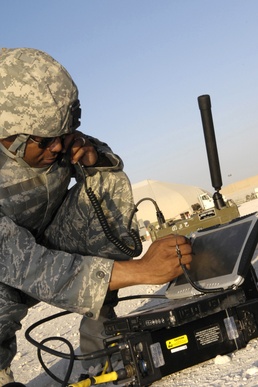
By Staff Sgt. Angie Perez
U.S. Central Command Air Forces Public Affairs
SOUTHWEST ASIA –U.S. Central Command Air Forces recently received its two-thousandth Remotely Operated Video Enhanced Receiver, a small laptop with an external antenna that allows Joint Terminal Attack Controllers on the ground to coordinate more accurate air strikes.
The seemingly unimpressive device is rapidly gaining popularity amongst military units throughout Iraq and Afghanistan.
"A picture is truly worth a thousands words," according to Lt. Col. Matthew Bannon, CENTAF Combined Air and Space Operations Center chief of reconnaissance. "With the ROVER, a JTAC can see a real-time video feed from the aircraft's targeting pod on his laptop allowing him to be right on target."
Before an aircraft can execute an air strike, the pilot receives permission from a JTAC on the ground. The JTACs confirm the location of the air strike to ensure minimal collateral damage and avoid injury to friendly forces. In the past, the pilot communicated with the controller via radio, describing what he saw from the air. The controller then compared it to his view from the ground, and if everything matched up, the controller gave the pilot permission to "go hot".
"The concept of the ROVER is to allow [JTAC's] to see from the eyes of the pilot," said Staff Sgt. Kenneth Swank, a JTAC assigned to the 25th Expeditionary Air Support Operations Squadron. "The video feed from an aircraft transmits to the screen below and we are able to guide the pilot to a specified target based on the landmarks seen from the air."
He also said the ROVER is very precise.
"We can even zoom in and see individuals running in and out of buildings and follow them through the entire city. It is also highly effective at tracking vehicles through congested streets," he said.
Because of this, the ROVER is a major player in the counter improvised explosive devices fight, helping to save numerous lives and thousands of dollars in equipment. Using the aircraft's thermal camera, it can identify hot or cold spots on the ground, and detect whether the ground has been disturbed.
The system also has civilian applications.
"ROVER has been proven useful not only in combat missions," said Maj. Jon Tinsley, 704th Expeditionary Support Squadron commander. "It has been used with Unmanned Aerial Vehicles for border surveillance on the U.S.-Mexican border and during Hurricane Katrina and disaster recoveries. It gives the ground man a chance to see what the aircraft is seeing without having to actually be in the aircraft."
The first generation ROVER (ROVER I) was introduced in 2004. Since then, improvements made it smaller, lighter and more efficient, resulting in the current model, ROVER III.
Within one year, the next two generations will make them even smaller with more upgrades, allowing for two-way encrypted communication thus making it even easier for JTAC's to complete their mission safely and efficiently.
In theater, every branch of the U.S. armed forces and multiple coalition partners are using the ROVER. It has become an essential tool in successful mission completion.
This highly praised system may not look impressive but it has the ability to save time, money and, most importantly, lives.